Life is a Color Wire [i]
('Het Leven is een Gekleurde Draad')
september 15, 2010.
Jan-Pieter (or Jean-Pierre) Minckeleers (or Minckelers, or Minkelers), born in Maastricht in the Netherlands and baptized there on december 2nd, 1748, was (one of) the discoverer(s) of gas production by carbonization. The scientist and inventor, who in 1771 became a professor of natural philosophy at the Catholic University of Leuven, originally applied this technique to - successfully - produce a lighter-than-air gas suitable for use in balloons. But Minckeleers also found that the gas thus produced was highly inflammable (he himself called it 'combustible air') and could be used for lighting purposes: he used it to illuminate his workshop at the Leuven University. He thus became one of the discoverers of the principle of gas lighting.
In 1789 Minckeleers moved back to Maastricht, where he practiced as a chemist.
He later became a teacher at the (French) Ecole centrale and Ecole
secondaire and, as a member of the local council (1801-1815), also
became politically active.
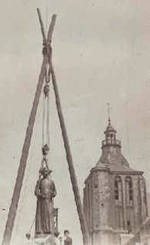 Thus Minckeleers spent a substantial part of his life in Maastricht and
also died in his native town, in 1824. This accounts for the fact that he
is still revered there as a scientist and inventor and was honored by becoming
the subject of what still is, arguably, Maastricht's most impressive, but
definitely most visible statue: Jean-Pierre can be seen
reaching up to a height of more than six meters above the surface of the
marketplace on a monumental pedestal at the head of the Boschstraat, holding
a torch with eternal burning flames that are also making an eternally restless
rustling sound.
Thus Minckeleers spent a substantial part of his life in Maastricht and
also died in his native town, in 1824. This accounts for the fact that he
is still revered there as a scientist and inventor and was honored by becoming
the subject of what still is, arguably, Maastricht's most impressive, but
definitely most visible statue: Jean-Pierre can be seen
reaching up to a height of more than six meters above the surface of the
marketplace on a monumental pedestal at the head of the Boschstraat, holding
a torch with eternal burning flames that are also making an eternally restless
rustling sound.
The bronze Minckeleers statue was designed by the Dutch sculptor Bart
van Hove and unveiled on july 10th 1904. It originally was meant to be placed right in front of the town hall on the Markt,
but eventually was set up more to the north, on the Boschstraat side of the municipal marketplace.
Here is a picture of the statue shot earlier this summer when, with the assistance of Intro In Situ's Paul Caron, I set out to capture the sound of the burning torch.
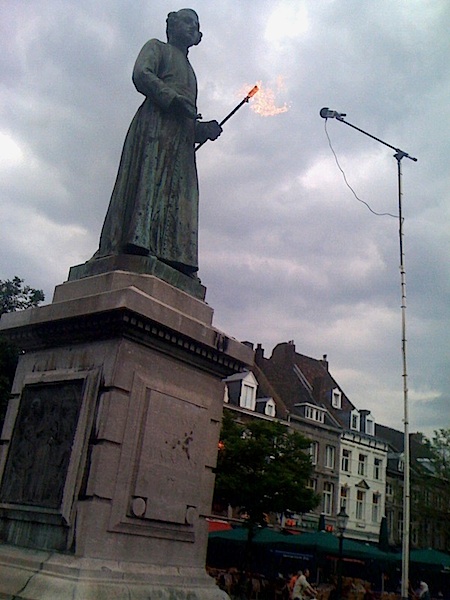
On the opposite side of the market and town hall, about 90 meters to the south of Minckeleers, stands a second, but very different, statue. Made in stone and about half the size of its majestic bronze opponent, it is called 't Mooswief, which is Maastricht dialect for 'greengrocerwoman'. Whereas pigeons, doves and gulls seem to mostly avoid coming anywhere near Minckeleers' head (surely because of the heat and agitation of the torch's flames), birds can be found contemplatively resting on top of the Mooswief at all time during the day. The statue's pedestal is set in a pentagonal basin, filled with water that, via a system of tubes, continuously is being pumped up into the pedestal and then spit out again into the five corners of the basin through five metal fish-heads.
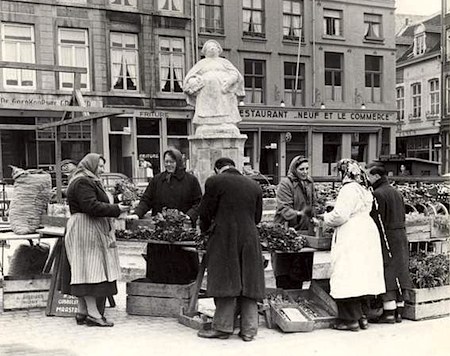
Behind the Mooswief's back, just across the street, Friture Reitz (since 1908) sells the best fries in town. At business hours many of Reitz' costumers can be found emptying oversized pointy paper fry bags seated on the brim of the basin, like in the picture that I made earlier this summer while recording also this statue's sounds.
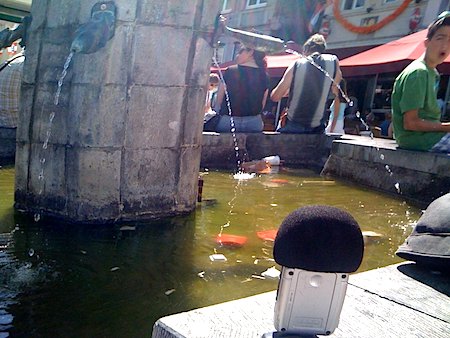
The statue of the anonymous greengrocerwoman represents the many women that formerly at cockcrow came from the surrounding rural communities to the city market, where they sold their products to the townspeople and bought colonial wares (coffee, tea, tobacco...) for their own use in return. The word - Mooswief - had (and still has) a derogative ring, being typical 'Maastricht slang' introduced by city dwellers who considered themselves to be far superior to the so much simpler souls that were living on the countryside. But of course these 'trading rural women' epitomized the fact that the marketplace was the city's center of trade, and in the early 1950s it was decided to sidestep the (playful or not) ridicule and for once and for all honor these greengrocerwomen by dedicating them a monument.
The Mooswief statue was made by Maastricht's 'municipal sculptor', Charles Vos, and unveiled on february 27th 1954, mere days after the sculptor's demise (on february 19th).
Whereas the seigneurial Minckeleers statue half a century earlier had been unveiled by Gustave Louis Marie Hubert Ruijs de Beerenbrouck, who was at the time the Queen's Commissioner (Gouverneur) for the Province of Limburg, the otherness of the Mooswief's statue's status (that of a symbol for and of the 'common people') is illustrated by the fact that it was unveiled by the Prince of the 1954 Maastricht Carnival, who symbolically reigns the city for the three day duration of this major and age old popular feast (that in Maastricht is celebrated in- and outdoors on a particularly large scale).
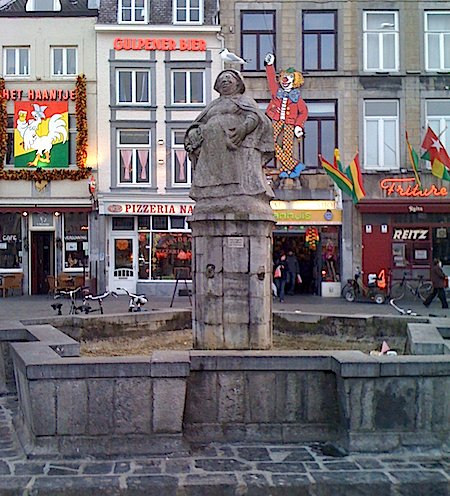
As of its unveiling by the 1954 Carnival Prince the Mooswief became a patron of the Maastricht Carnival: a gigantic papier-mâché Mooswief doll was made, that at the beginning of each Carnival is ceremonially raised on a flagpole to be lowered and put away again three days later when the festivities officially end. And every year still the Maastricht Carnival Prince will mount the Charles Vos statue, embrace it and decorate it with a garland made out of vegetables, as shown in the two pictures below (these are stills from a uTube clip of this ceremony as it was performed during the 2009 carnival in Maastricht).
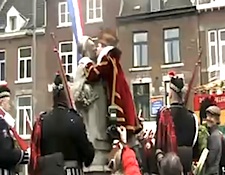 |
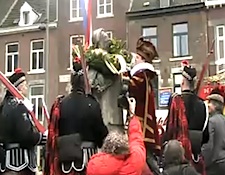 |
[ continue to -> Life is a Color Wire 2 ]
...
tags: Maastricht, Mooswief, Minckeleers
# .388.
comments for Life is a Color Wire [i] ::
|
Comments are disabled |